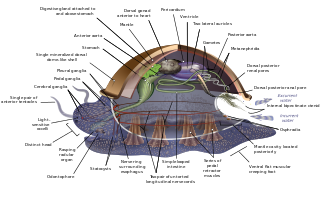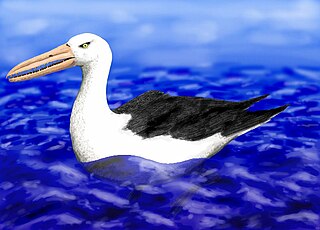Related Research Articles

The Bayan Shireh Formation is a geological formation in Mongolia, that dates to the Cretaceous period. It was first described and established by Vasiliev et al. 1959.

The evolution of the molluscs is the way in which the Mollusca, one of the largest groups of invertebrate animals, evolved. This phylum includes gastropods, bivalves, scaphopods, cephalopods, and several other groups. The fossil record of mollusks is relatively complete, and they are well represented in most fossil-bearing marine strata. Very early organisms which have dubiously been compared to molluscs include Kimberella and Odontogriphus.

Osteodontornis is an extinct seabird genus. It contains a single named species, Osteodontornis orri, which was described quite exactly one century after the first species of the Pelagornithidae was. O. orri was named after Santa Barbara Museum of Natural History paleontologist Phil C. Orr, for his recognition of the importance of the specimen.

Odontogriphus is a genus of soft-bodied animals known from middle Cambrian Lagerstätte. Reaching as much as 12.5 centimetres (4.9 in) in length, Odontogriphus is a flat, oval bilaterian which apparently had a single muscular foot and a "shell" on its back that was moderately rigid but of a material unsuited to fossilization.

The Gryphaeidae, common name the foam oysters or honeycomb oysters, are a family of marine bivalve mollusks. This family of bivalves is very well represented in the fossil record, however the number of living species is very few.
Harold John Finlay was a New Zealand palaeontologist and conchologist.
The Yushima Formation, also known as the Tatsunokuchi Formation, is a palaeontological formation in Japan, dating to the Lower Pliocene period.

The Norwich Crag Formation is a stratigraphic unit of the British Pleistocene Epoch. It is the second youngest unit of the Crag Group, a sequence of four geological formations spanning the Pliocene to Lower Pleistocene transition in East Anglia. It was deposited between approximately 2.4 and 1.8 million years ago, during the Gelasian Stage.
This list, 2014 in molluscan paleontology, is a list of new taxa of ammonites and other fossil cephalopods, as well as fossil gastropods, bivalves and other molluscs that have been described during the year 2014.
The Morawan Formation is a Chattian age siliceous marine geological formation of the Oligo-Miocene Japanese Kawakami Group of eastern Hokkaido prefecture. The formation is fossil rich and contains source units where toothed baleen whales (Aetiocetidae) and Desmostylians have been discovered.

Kelletia lischkei is a species of large sea snail, or whelk, a marine gastropod mollusc in the family Austrosiphonidae.
Mininco Formation is a geological formation composed of sediments that deposited during the Pliocene in central Chile. Near Angol the formation reaches thicknesses of up to 300 m. The upper strata of the formation contain tuff layers and coal beds that are rich in leaf fossils. Other fossils that have been found in the formation include fresh-water diatoms and bivalves.
Paradrillia dainichiensis is a species of sea snail, a marine gastropod mollusk in the family Horaiclavidae.

The Bokkeveld Group is the second of the three main subdivisions of the Cape Supergroup in South Africa. It overlies the Table Mountain Group and underlies the Witteberg Group. The Bokkeveld Group rocks are considered to range between Lower Devonian (Lochkovian) to Middle Devonian (Givetian) in age.
The Algoa Group is one of five geological groups which comprise the coastal Cenozoic geological deposits in South Africa. The Algoa Group contains six formations which range from Middle Eocene to Late Holocene in age.

The Wanganui Basin is an onshore-offshore basin on the North Island of New Zealand. The basin provides an important stratigraphic and palaeontological record for the late Neogene marine environment of New Zealand.
Kuroshioturris kurodai is a species of sea snail, a marine gastropod mollusk in the family Turridae, the turrids.
This list of fossil molluscs described in 2022 is a list of new taxa of fossil molluscs that were described during the year 2022, as well as other significant discoveries and events related to molluscan paleontology that occurred in 2022.
This list of fossil molluscs described in 2023 is a list of new taxa of fossil molluscs that were described during the year 2023, as well as other significant discoveries and events related to molluscan paleontology that occurred in 2023.
References
- ↑ Ryuichi Majima; Takashi Homme (August 1993). "Shell-concentrated bed of the Dainichi Formation of the Kakegawa Group. Its fabric and origin" (PDF). Journal of the Geological Society of Japan (in Japanese). 99 (8): 659–674. doi:10.5575/geosoc.99.659 . Retrieved 2022-12-30.
- ↑ Susumu Tonida; Masahiro Shiba; Takami Nobuhara (February 2006). "First post-Miocene Argonauta from Japan, and its Palaeontological Significance" (PDF). Cainozoic Research.
- ↑ Yuri Kimura; Yoshiharu Yokoyama; Hiromichi Hirano (September 2011). "Stratigraphic trends in molluscan paleoecology in storm-generated shell beds from the lower shoreface deposits of the Pliocene Dainichi Formation, Kakegawa Group, central Japan". Fossils (90): 5–15. Retrieved 2022-12-30.
- ↑ Nobuhara, T.; Tanaka, T. "A new subspecies of Rhizoconus hyaena (Caenogastropoda: Conidae) from the upper pliocene Dainichi formation, Shizuoka prefecture, central Japan". Japanese Journal of Malacology.